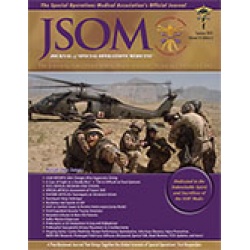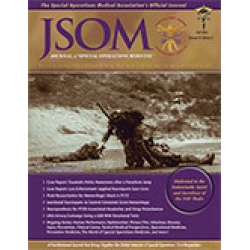Breakaway Media, LLC

Winter 2018 Journal (Vol 18 Ed 4)
Vol 18 Ed 4
Winter 2018 Journal of Special Operations Medicine
ISSN: 1553-9768
Fall 2019 Journal (Vol 19 Ed 3)
Vol 19 Ed 3
Fall 2019 Journal of Special Operations Medicine
ISSN: 1553-9768
Summer 2019 Journal (Vol 19 Ed 2)
Vol 19 Ed 2
Summer 2019 Journal of Special Operations Medicine
ISSN: 1553-9768
Fall 2016 Journal (Vol 16 Ed 3)
Vol 16 Ed 3
Fall 2016 Journal of Special Operations Medicine
ISSN: 1553-9768
Winter 2015 Journal (Vol 15 Ed 4)
Vol 15 Ed 4
Winter 2015 Journal of Special Operations Medicine
ISSN: 1553-9768
Winter 2015 Journal of Special Operations Medicine
ISSN: 1553-9768
Summer 2016 Journal (Vol 16 Ed 2)
Vol 16 Ed 2
Summer 2016 Journal of Special Operations Medicine
ISSN: 1553-9768
Winter 2011 Journal (Vol 11 Ed 4)
Vol 11 Ed 4
Winter 2011 Journal of Special Operations Medicine
ISSN: 1553-9768
Fall 2012 Journal (Vol 12 Ed 3)
Vol 12 Ed 3
Fall 2012 Journal of Special Operations Medicine
ISSN: 1553-9768
Fall 2012 Journal of Special Operations Medicine
ISSN: 1553-9768
Spring 2012 Journal (Vol 12 Ed 1)
Vol 12 Ed 1
Spring 2012 Journal of Special Operations Medicine
ISSN: 1553-9768
Spring 2012 Journal of Special Operations Medicine
ISSN: 1553-9768
Winter 2012 Journal (Vol 12 Ed 4)
Vol 12 Ed 4
Winter 2012 Journal of Special Operations Medicine
ISSN: 1553-9768
Winter 2012 Journal of Special Operations Medicine
ISSN: 1553-9768
Winter 2013 Journal (Vol 13 Ed 4) (Digital Download Only)
Vol 13 Ed 4
Winter 2013 Journal of Special Operations Medicine
ISSN: 1553-9768 This edition is currently out of print and is available as a PDF download only. Upon completion of your purchase, this title will be added to your account and you may download it immediately.
Winter 2013 Journal of Special Operations Medicine
ISSN: 1553-9768 This edition is currently out of print and is available as a PDF download only. Upon completion of your purchase, this title will be added to your account and you may download it immediately.
Fall 2013 Journal (Vol 13 Ed 3) (Digital Download Only)
Vol 13 Ed 3
Fall 2013 Journal of Special Operations Medicine
ISSN: 1553-9768 This edition is currently out of print and is available as a PDF download only. Upon completion of your purchase, this title will be added to your inventory and you may download it immediately.
Fall 2013 Journal of Special Operations Medicine
ISSN: 1553-9768 This edition is currently out of print and is available as a PDF download only. Upon completion of your purchase, this title will be added to your inventory and you may download it immediately.
Summer 2013 Journal (Vol 13 Ed 2) (Digital Download Only)
Vol 13 Ed 2
Summer 2013 Journal of Special Operations Medicine
ISSN: 1553-9768 This edition is currently out of print and is available only as a PDF download. Upon completion of your purchase, this title will be added to your account and you may download it immediately.
Summer 2013 Journal of Special Operations Medicine
ISSN: 1553-9768 This edition is currently out of print and is available only as a PDF download. Upon completion of your purchase, this title will be added to your account and you may download it immediately.
Spring 2013 Journal (Vol 13 Ed 1) (Digital Download Only)
Vol 13 Ed 1
Spring 2013 Journal of Special Operations Medicine
ISSN: 1553-9768 This edition is currently out of print and is available as a PDF download. Upon completion of your purchase, this title will be added to your account and you will be able to download it immediately.
Spring 2013 Journal of Special Operations Medicine
ISSN: 1553-9768 This edition is currently out of print and is available as a PDF download. Upon completion of your purchase, this title will be added to your account and you will be able to download it immediately.
Spring 2014 Journal (Vol 14 Ed 1)
Vol 14 Ed 1
Spring 2014 Journal of Special Operations Medicine
ISSN: 1553-9768
Spring 2014 Journal of Special Operations Medicine
ISSN: 1553-9768
Fall 2014 Journal (Vol 14 Ed 3)
Vol 14 Ed 3
Fall 2014 Journal of Special Operations Medicine
ISSN: 1553-9768
Fall 2014 Journal of Special Operations Medicine
ISSN: 1553-9768
Winter 2014 Journal (Vol 14 Ed 4)
Vol 14 Ed 4
Winter 2014 Journal of Special Operations Medicine
ISSN: 1553-9768
Winter 2014 Journal of Special Operations Medicine
ISSN: 1553-9768
Spring 2015 Journal (Vol 15 Ed 1) (Digital Download Only)
Vol 15 Ed 1
Spring 2015 Journal of Special Operations Medicine
ISSN: 1553-9768 This edition is out of print and is available as a PDF download only. Upon receipt of payment, this title will be added to your account and you may download it at your convenience.
Spring 2015 Journal of Special Operations Medicine
ISSN: 1553-9768 This edition is out of print and is available as a PDF download only. Upon receipt of payment, this title will be added to your account and you may download it at your convenience.
Summer 2015 Journal (Vol 15 Ed 2)
Vol 15 Ed 2
Summer 2015 Journal of Special Operations Medicine
ISSN: 1553-9768
Summer 2015 Journal of Special Operations Medicine
ISSN: 1553-9768
Fall 2015 Journal (Vol 15 Ed 3)
Vol 15 Ed 3
Fall 2015 Journal of Special Operations Medicine
ISSN: 1553-9768
Fall 2015 Journal of Special Operations Medicine
ISSN: 1553-9768


 Español
Español 



















